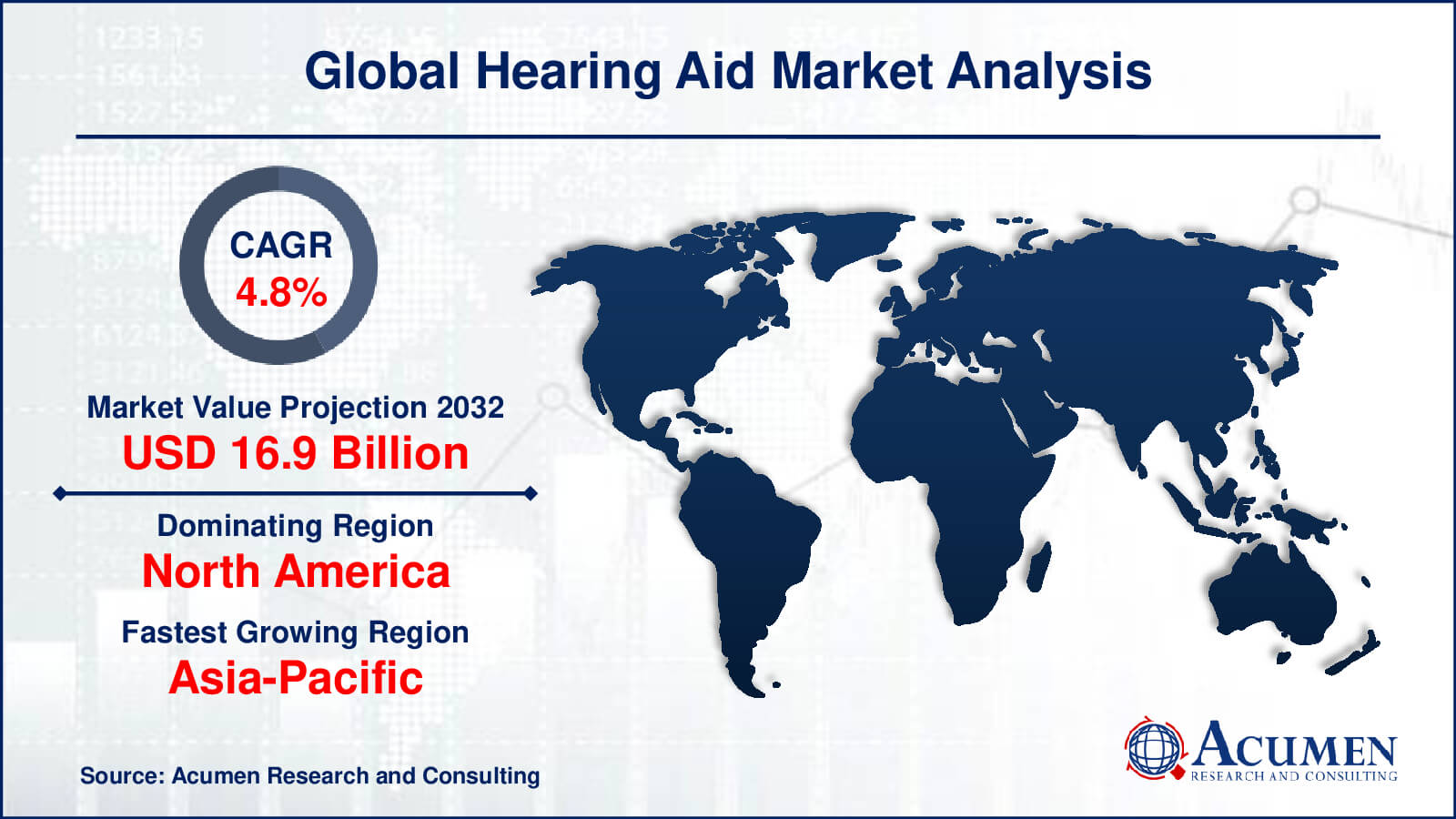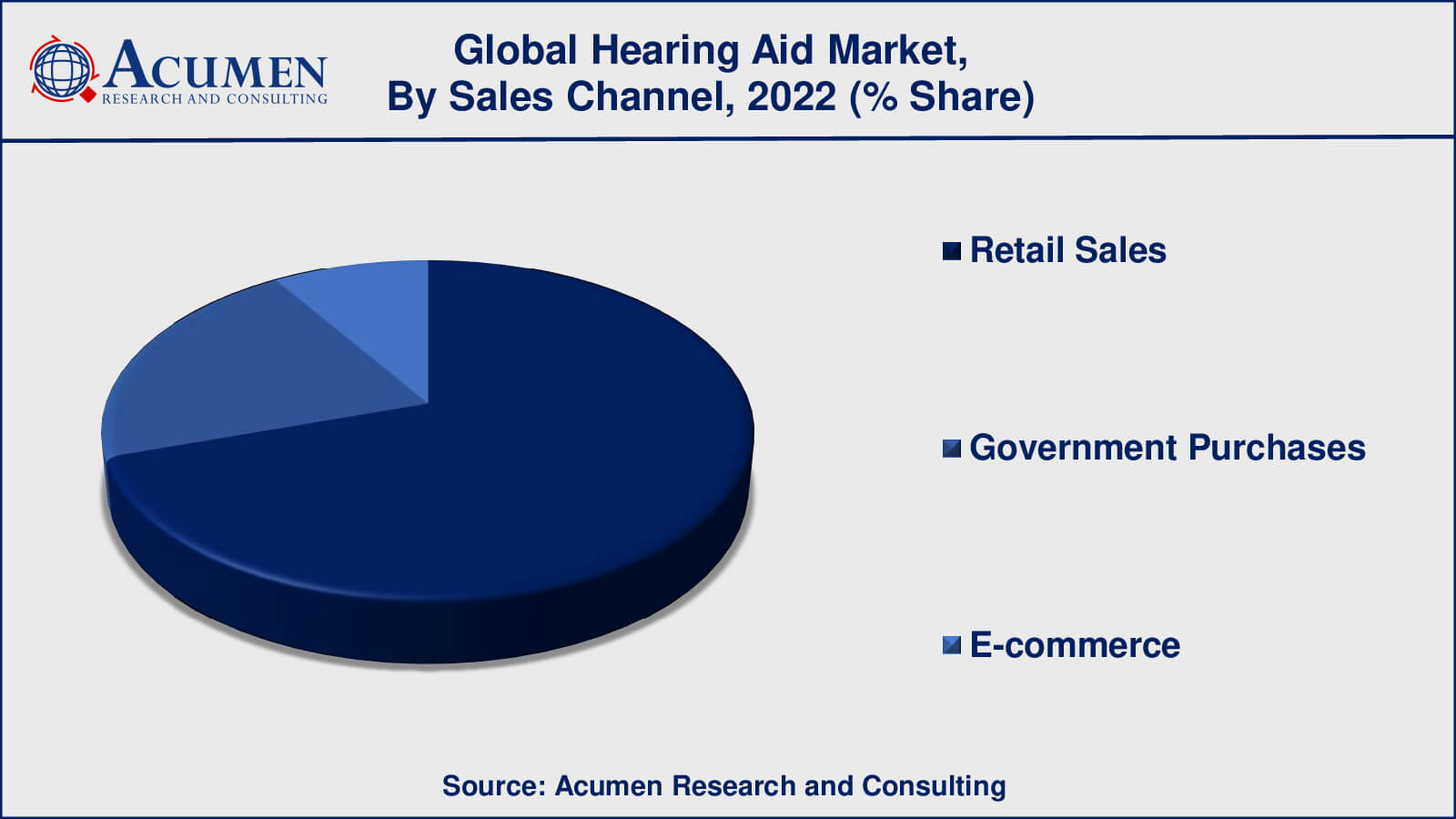Hearing Aid Market | Acumen Research and Consulting
Hearing Aid Market Size - Global Industry, Share, Analysis, Trends and Forecast 2023 - 2032
Published :
Report ID:
Pages :
Format :
The Global Hearing Aid Market Size accounted for USD 10.6 Billion in 2022 and is estimated to achieve a market size of USD 16.9 Billion by 2032 growing at a CAGR of 4.8% from 2023 to 2032.
Hearing Aid Market Key Highlights
- Global hearing aid market revenue is poised to garner USD 16.9 billion by 2032 with a CAGR of 4.8% from 2023 to 2032
- Europe hearing aid market value occupied more than USD 3.7 billion in 2022
- Asia-Pacific hearing aid market growth will record a CAGR of around 5% from 2023 to 2032
- Among product type, the behind-the-ear hearing aids sub-segment generated around 41% share in 2022
- Based on sales channel, the retail sales sub-segment generated around US$ 7.4 billion revenue in 2022
- Increasing adoption of OTC hearing aids is popular hearing aid market trends that fuels the industry demand

A hearing aid is a device mainly designed to enhance and improve the hearing capabilities of people suffering from hearing ailments and hearing disorders. Hearing aids come under the category of medical devices and are regulated by various governmental regulations. Earlier, ear horns or ear trumpets were largely preferred as they involved passive amplification cones intended to gather sound energy to direct it into the ear drums. Modern hearing aids are generally computerized and are able to transform environmental sounds to more comfortable and intelligible levels. Modern hearing aids need specific configurations to match the hearing loss and physical features and depend from person to person. Devices such as cochlear implants and bone-anchored hearing aid are similar to simple hearing aid devices.

Global Hearing Aid Market Dynamics
Market Drivers
- Growing prevalence of hearing loss
- Rising base of elderly people
- Increasing disposable income
- Increased awareness and acceptance
Market Restraints
- High cost of these devices
- Limited insurance coverage
- Stigma attached to hearing aids
Market Opportunities
- Growing demand for wireless hearing aids
- Surging government initiatives
Hearing Aid Market Report Coverage
| Market | Hearing Aid Market |
| Hearing Aid Market Size 2022 | USD 10.6 Billion |
| Hearing Aid Market Forecast 2032 | USD 16.9 Billion |
| Hearing Aid Market CAGR During 2023 - 2032 | 4.8% |
| Hearing Aid Market Analysis Period | 2020 - 2032 |
| Hearing Aid Market Base Year | 2022 |
| Hearing Aid Market Forecast Data | 2023 - 2032 |
| Segments Covered | By Product Type, By Patient Type, By Technology Type, By Type of Hearing Loss, By Sales Channel, And By Geography |
| Regional Scope | North America, Europe, Asia Pacific, Latin America, and Middle East & Africa |
| Key Companies Profiled | GN Store Nord A/S, Medtronic, SeboTek Hearing Systems, Sonova, Widex, Cochlear Limited, MED-EL, Demant A/S, Zounds Hearing Inc., and Sivantos Pte Ltd. |
| Report Coverage |
Market Trends, Drivers, Restraints, Competitive Analysis, Player Profiling, Covid-19 Analysis, Regulation Analysis |
Hearing Aid Market Insights
Increasing incidences of hearing disorders among the geriatric population have propelled the overall sale of accurate and effective hearing aid devices. Hearing disabilities among newborn infants, as well as war veterans, are also an important concern. The demand for efficient hearing aid devices is gaining popularity and preference since untreated hearing loss may result in permanent impairment in speaking as well and may affect the overall psychological and academic abilities of the suffering infant. Moreover, since the global geriatric population is strongly susceptible to hearing damage, this population segment can crucially affect personal relationships and social lives. Due to this, the global hearing aids market is anticipated to account for significant growth and thus the global demand for hearing aid devices is expected to increase over the forecast period.
Since the geriatric population is relatively more prone to evolve hearing disorders and impairments, the demand for hearing aid devices is directly affected by the geriatric demographic across the globe. Over the past few years, health awareness among patients concerning hearing impairment has witnessed a considerable increase. Also, recent technological advancements in hearing aids are a key factor driving the sales of hearing aid devices worldwide. In addition, the introduction of rechargeable hearing aids with quick charging features and long-lasting battery lives is also expected to augment the growth of the global hearing aid market. Moreover, the increasing prevalence of deafness, especially due to an increase in levels of noise pollution, ear infections, genetic factors, and birth complications is another key factor propelling the growth of the global hearing aid market. Furthermore, an increase in demand for aesthetically appealing miniature devices is anticipated to boost the growth of the global hearing aid market.

Hearing Aid Market Segmentation
The worldwide market for hearing aid is split based on product type, patient type, technology type, type of hearing loss, sales channel, and geography.
Hearing Aid Product Types
- In-the-Ear Hearing Aids
- Receiver in-the-Ear Hearing Aids
- Behind-the-Ear Hearing Aids
- Canal Hearing Aids

According to the hearing aid industry analysis, the behind-the-ear hearing aids sub-segment generated the highest revenue in 2022. BTE hearing aids are generally thought to have better sound quality than other types of hearing aids, especially for people who have severe to profound hearing loss. BTE hearing aids are comfortable to wear and do not obstruct the ear canal, which some users find uncomfortable. BTE hearing aids are popular among users because they can be customised to fit individual preferences and hearing needs. BTE hearing aids are more durable than other types of hearing aids, which is beneficial for people who lead active lives. Many BTE hearing aids are now wirelessly connected, allowing users to connect to smartphones, televisions, and other devices.
Hearing Aid Patient Types
- Adults
- Pediatrics
Adults have traditionally been the most common patient type in the hearing aid market. This is because hearing loss is more common in adults, particularly among the elderly. According to the World Health Organization, approximately 466 million people worldwide have disabling hearing loss, with adults over the age of 65 constituting the majority of these individuals.
Furthermore, because they are more aware of the impact of hearing loss on their daily lives, adults with hearing loss seem to be more likely to seek out and use hearing aids. Pediatric hearing loss, on the other hand, is uncommon and frequently detected at a young age through screening programmes. Hearing aids or assistive listening devices for children with hearing loss, such as cochlear implants, are more specialised and require a different approach to fitting and management.
Hearing Aid Technologies
- Analog
- Digital
According to the hearing aid market forecast, digital technology is expected to gain a significant market share between 2023 and 2032. Digital hearing aids can process sound more accurately and effectively than analogue hearing aids, providing users with better sound quality. Individual hearing needs and preferences can be met with digital hearing aids, making them a more personalised solution for hearing loss. Advanced noise reduction technology is built into digital hearing aids, which can reduce background noise and enhance speech recognition in noisy environments. Many digital hearing aids now include wireless connectivity, which allows users to connect to smartphones, televisions, and other devices.
Hearing Aid Type of Hearing Loss
- Sensorineural Hearing Loss
- Conductive Hearing Loss
Sensorineural hearing loss is the most common type of hearing loss and the one that most often necessitates the use of hearing aids. As a result, the vast majority of hearing aids on the market are intended to assist people with sensorineural hearing loss.
Sensorineural hearing loss occurs when the inner ear or auditory nerve is damaged, which can be caused by age-related hearing loss, loud noise exposure, or certain medical conditions. Hearing loss of this type typically impairs a person's ability to hear high-pitched sounds and understand speech.
Conversely, conductive hearing loss is caused by a blockage or damage to the outer or middle ear, which can help stop sound from reaching the inner ear. Conductive hearing loss is often treated with medication or surgery, but hearing aids may also be recommended in some cases to help improve hearing.
Hearing Aid Sales Channels
- Retail Sales
- Government Purchases
- E-Commerce

Retail sales have historically been the dominant sales channel in the hearing aid market. This is because hearing aids require professional fitting and adjustments, which are typically provided by hearing healthcare professionals such as audiologists or hearing aid dispensers. As such, most hearing aids are purchased through retail channels, such as hearing clinics, hospitals, and independent audiology practices.
However, in recent years, e-commerce has emerged as a growing sales channel for hearing aids. This is due to several factors, such as increased consumer demand for online shopping, the convenience of home delivery, and the availability of teleaudiology services that enable remote hearing aid fittings and adjustments.
Hearing Aid Market Regional Outlook
North America
- U.S.
- Canada
Europe
- U.K.
- Germany
- France
- Spain
- Rest of Europe
Asia-Pacific
- India
- Japan
- China
- Australia
- South Korea
- Rest of Asia-Pacific
Latin America
- Brazil
- Mexico
- Rest of Latin America
The Middle East & Africa
- South Africa
- GCC Countries
- Rest of the Middle East & Africa (ME&A)
Hearing Aid Regional Analysis
The North American hearing aid market is the largest in the world, driven by a combination of factors such as an ageing population, increased hearing aid awareness and acceptance, and favorable reimbursement policies. The United States is the region's largest market, accounting for the majority of North American market share.
The European hearing aid market is also significant, with factors such as an ageing population, an increase in the prevalence of hearing loss, and favorable reimbursement policies driving demand. The region's largest markets are Germany, France, and the United Kingdom.
The Asia-Pacific hearing aid market is expanding rapidly as a result of several factors, including rising healthcare spending, increased awareness and acceptance of hearing aids, and a large elderly population. China, Japan, and India are the largest markets in the region.
Hearing Aid Market Players
Some of the top hearing aid companies offered in the professional report include GN Store Nord A/S, Medtronic, SeboTek Hearing Systems, Sonova, Widex, Cochlear Limited, MED-EL, Demant A/S, Zounds Hearing Inc., and Sivantos Pte Ltd.
Frequently Asked Questions
What was the market size of the global hearing aid in 2022?
The market size of hearing aid was USD 10.6 billion in 2022.
What is the CAGR of the global hearing aid market from 2023 to 2032?
The CAGR of hearing aid is 4.8% during the analysis period of 2023 to 2032.
Which are the key players in the hearing aid market?
The key players operating in the global market are including GN Store Nord A/S, Medtronic, SeboTek Hearing Systems, Sonova, Widex, Cochlear Limited, MED-EL, Demant A/S, Zounds Hearing Inc., and Sivantos Pte Ltd.
Which region dominated the global hearing aid market share?
North America held the dominating position in hearing aid industry during the analysis period of 2023 to 2032.
Which region registered fastest CAGR from 2023 to 2032?
Asia-Pacific region exhibited fastest growing CAGR for market of hearing aid during the analysis period of 2023 to 2032.
What are the current trends and dynamics in the global hearing aid industry?
The current trends and dynamics in the hearing aid industry include growing prevalence of hearing loss, rising base of elderly people, and increasing disposable income.
Which product type held the maximum share in 2022?
The behind-the-ear hearing aid product type held the maximum share of the hearing aid industry.


